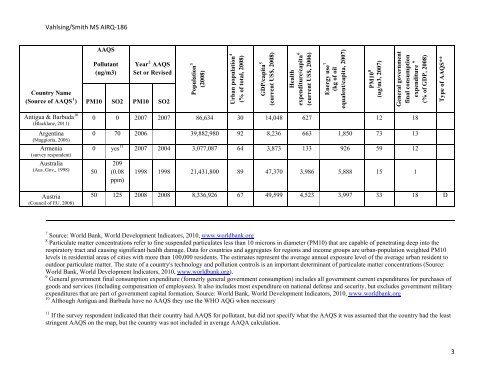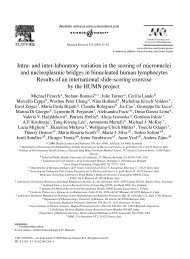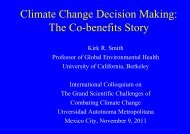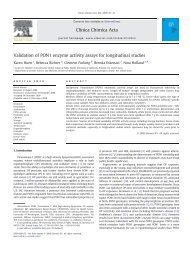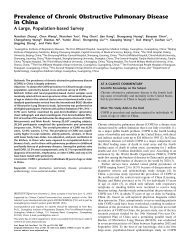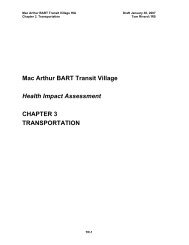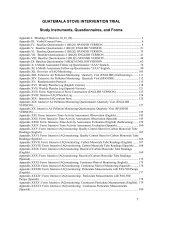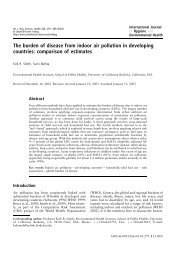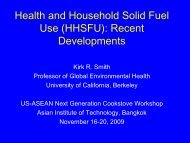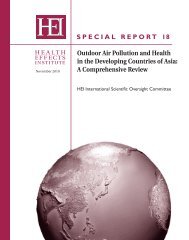Global review of national ambient air quality standards for PM10 and ...
Global review of national ambient air quality standards for PM10 and ...
Global review of national ambient air quality standards for PM10 and ...
Create successful ePaper yourself
Turn your PDF publications into a flip-book with our unique Google optimized e-Paper software.
Vahlsing/Smith MS AIRQ‐186AAQSPollutant(ug/m3)Year 2 AAQSSet or RevisedCountry Name(Source <strong>of</strong> AAQS 1 ) <strong>PM10</strong> SO2 <strong>PM10</strong> SO2Population 3(2008)Urban population 4(% <strong>of</strong> total, 2008)GDP/capita 5(current US$, 2008)Healthexpenditure/capita 6(current US$, 2006)Energy use 7(kg <strong>of</strong> oilequalent/capita, 2007)<strong>PM10</strong> 8(ug/m3, 2007)General governmentfinal consumptionexpenditure 9(% <strong>of</strong> GDP, 2008)Type <strong>of</strong> AAQS**Antigua & Barbuda 10(Blacklane, 2011)0 0 2007 2007 86,634 30 14,048 627 12 18Argentina(Maggioria, 2006)Armenia(survey respondent)Australia(Aus. Gov., 1998)500 70 2006 39,882,980 92 8,236 663 1,850 73 130 yes 11 2007 2004 3,077,087 64 3,873 133 926 59 12209(0.08ppm)1998 1998 21,431,800 89 47,370 3,986 5,888 15 1Austria(Council <strong>of</strong> EU, 2008)50 125 2008 2008 8,336,926 67 49,599 4,523 3,997 33 18 D7 Source: World Bank, World Development Indicators, 2010, www.worldbank.org8 Particulate matter concentrations refer to fine suspended particulates less than 10 microns in diameter (<strong>PM10</strong>) that are capable <strong>of</strong> penetrating deep into therespiratory tract <strong>and</strong> causing significant health damage. Data <strong>for</strong> countries <strong>and</strong> aggregates <strong>for</strong> regions <strong>and</strong> income groups are urban-population weighted <strong>PM10</strong>levels in residential areas <strong>of</strong> cities with more than 100,000 residents. The estimates represent the average annual exposure level <strong>of</strong> the average urban resident tooutdoor particulate matter. The state <strong>of</strong> a country's technology <strong>and</strong> pollution controls is an important determinant <strong>of</strong> particulate matter concentrations (Source:World Bank, World Development Indicators, 2010, www.worldbank.org).9 General government final consumption expenditure (<strong>for</strong>merly general government consumption) includes all government current expenditures <strong>for</strong> purchases <strong>of</strong>goods <strong>and</strong> services (including compensation <strong>of</strong> employees). It also includes most expenditure on <strong>national</strong> defense <strong>and</strong> security, but excludes government militaryexpenditures that are part <strong>of</strong> government capital <strong>for</strong>mation. Source: World Bank, World Development Indicators, 2010, www.worldbank.org10 Although Antigua <strong>and</strong> Barbuda have no AAQS they use the WHO AQG when necessary11 If the survey respondent indicated that their country had AAQS <strong>for</strong> pollutant, but did not specify what the AAQS it was assumed that the country had the leaststringent AAQS on the map, but the country was not included in average AAQA calculation.3


